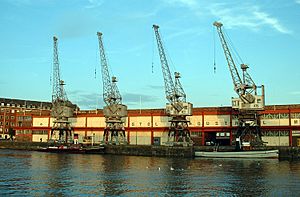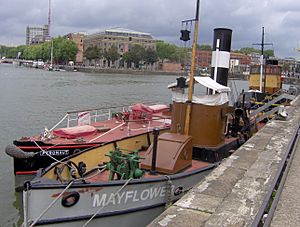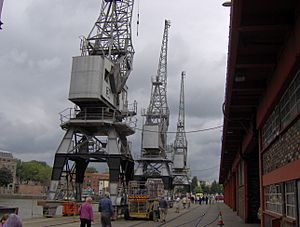Bristol Industrial Museum facts for kids
 |
|
| Lua error in Module:Location_map at line 420: attempt to index field 'wikibase' (a nil value). | |
| Location | Bristol |
|---|---|
The Bristol Industrial Museum was a museum in Bristol, England. It was located on Prince's Wharf, right next to the Floating Harbour. This museum closed in 2006. It showed off items from Bristol's amazing industrial past. This included things like airplanes, cars, buses, and printing machines. It also shared stories about Bristol's history with the sea.
Bristol City Council managed the museum. They also looked after old industrial items nearby. These included the Bristol Harbour Railway, big cranes, and a small group of old ships. These railway, cranes, and ships are now part of the working exhibits at M Shed Museum.
The museum closed its doors on October 29, 2006. A new museum, called M Shed, was built on the same spot. It kept the old building's front and many of the original exhibits. M Shed opened on June 17, 2011.
Contents
Exploring Bristol's Past
The museum's indoor exhibits were inside a former storage building by the docks. It had two floors filled with interesting displays.
Road Transport History
On the lower floor, you could find the transport gallery. This area showed various land transport exhibits. Many of these had a special connection to Bristol.
Exhibits included what is thought to be the world's first holiday caravan. You could compare it with a caravan from the 1950s. There was also the Grenville steam carriage, bicycles, motorcycles, cars, carriages, and buses.
Bristol's Aviation Story
The upper floor had the aviation gallery. This section told the story of Bristol's role in making aircraft. It featured a collection of Bristol-made aero engines. You could also see a Bristol-built helicopter. A mock-up flight deck of Concorde was also on display. Scale models showed the many different aircraft built in the city.
On the same floor, the story of the Port of Bristol was told. This was shown with models, paintings, and other exhibits.
Print & Pack Industry
The Print & Pack gallery was right next door. It explained the history of one of Bristol's biggest industries. You could see old machines and products. This was a very popular exhibit because it often had live demonstrations. You could watch printing machines like Linotype and Letterpress in action. These machines even printed many of the museum's own leaflets and tickets.
Bristol and Transatlantic History
Another gallery in the museum was called Bristol and Transatlantic Slavery. This exhibit shared the story of Bristol's part in a historical trade system. This system involved people from the UK, Africa, and the Caribbean. The gallery covered its early days, how it was ended, and its impact up to recent times. It helped visitors understand this important part of history.
Historic Ships, Cranes, and Trains
A collection of historic vessels was usually moored in front of the museum. This included the 1934 fireboat Pyronaut. There were also two tugs. One was John King, a diesel tug built in 1935. The other was Mayflower, the world's oldest surviving steam tug, built in 1861.
On the quayside outside the museum, you could see four large cargo cranes. These were built in 1951 by Stothert & Pitt and ran on electricity. A short distance away was a much older crane. This was a Fairbairn steam crane from 1878. It is the only working example left of its kind. It was used regularly until 1973 to load and unload ships and railway wagons. It could lift up to 35 tons. This crane has been fixed up and still works. It operates on some bank holidays and during the Bristol Harbour Festival.
The Bristol Harbour Railway still offers train rides along the quayside. These rides happen on bank holidays. They use restored steam locomotives and old railway cars.




